TILES AND TURTLES [DAY 3]
GEOMETRY - TRANSFORMATIONS
Explore concepts relating to rigid motion transformations.
Intentionality
Spark Curiosity
Fuel Sense Making
During Moves
Math Forum
Reflect and Consolidation Prompts
Resources & Downloads
Educator Discussion Area
Intentionality & Unit Overview
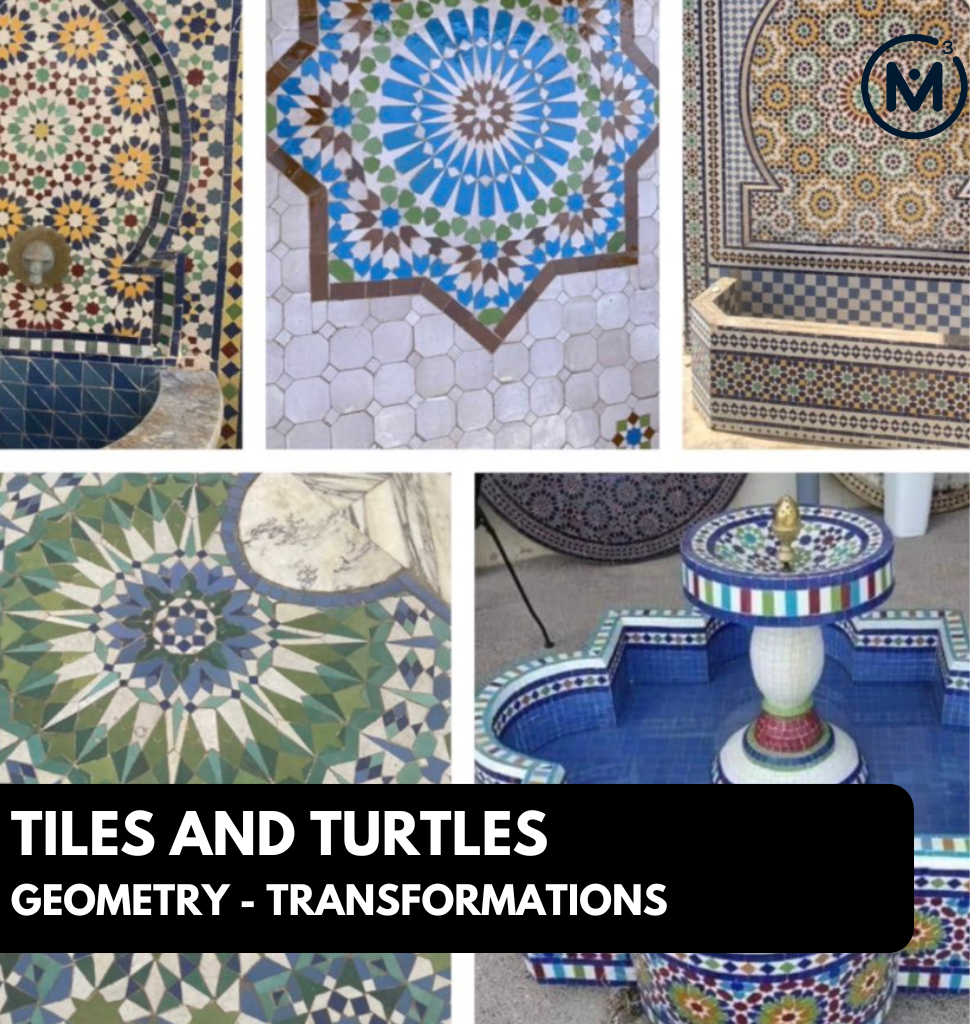
Length of Unit: 5 Days
Access each lesson from this unit using the navigation links below
Students will build on a previous context of mosaic tile to begin to investigate transformations on a coordinate plane.
Intentionality…
In this task, students will build on the experiences from Day 1 and the conceptual understanding of transformations to begin to develop an understanding of transformations on a coordinate plane. As part of their investigation, they will make and test conjectures about the result of various transformations, thus verifying experimentally the properties of reflections, rotations and translations. This will both further solidify their understanding of the transformational approach to congruence, as well as preparing students for understanding dilations and similarity.
Prerequisite skills include an understanding of the coordinate plane (all four quadrants), typically introduced in previous grades.
As the format of the lesson is investigative, it may be worthwhile to consider carrying the lesson out over more than one day, investigating one type of transformation at a time, or to set up stations in a workshop format. Students begin by exploring simple transformations, but the goal is to emerge ideas that can be verified with cases that are increasingly challenging and to uncover misconceptions or over-generalizations.
Some of the general big ideas that will likely emerge in this task include:
- two figures on a plane are congruent if there exists a series of basic rigid motions that will map one figure onto another
- basic rigid motions (translations, rotations, reflections) preserve distances and angle measures of figures
Some of the ideas specific to each type of transformation include:
Translations
- Translations require a distance and a direction
- Line segments of a translated figure are parallel to the corresponding segments in a preimage.
- The distance and direction of a translation (horizontal and vertical movement) is directly related to changes in the x and y variables
Rotations
Are students able to accurately and precisely describe rotations?
- Rotations require a center of rotation, degree of rotation and direction (clockwise or counterclockwise)
- All points on a figure are rotated the same number of degrees around the point of rotation, in the same direction.
Reflections
Are students able to accurately and precisely describe reflections?
- Reflections require a line of reflection.
- All the points on a figure are equidistant from the line of reflection.
What You’ll Need…
A variety of tools for students to use to think through the problems, such as:
- Patty paper
- MIRA /GeoMirrors
- Grid paper
- scissors
- centimeter paper
- Whiteboards & markers
Spark Curiosity
What Do You Notice? What Do You Wonder?
Show students the following image:
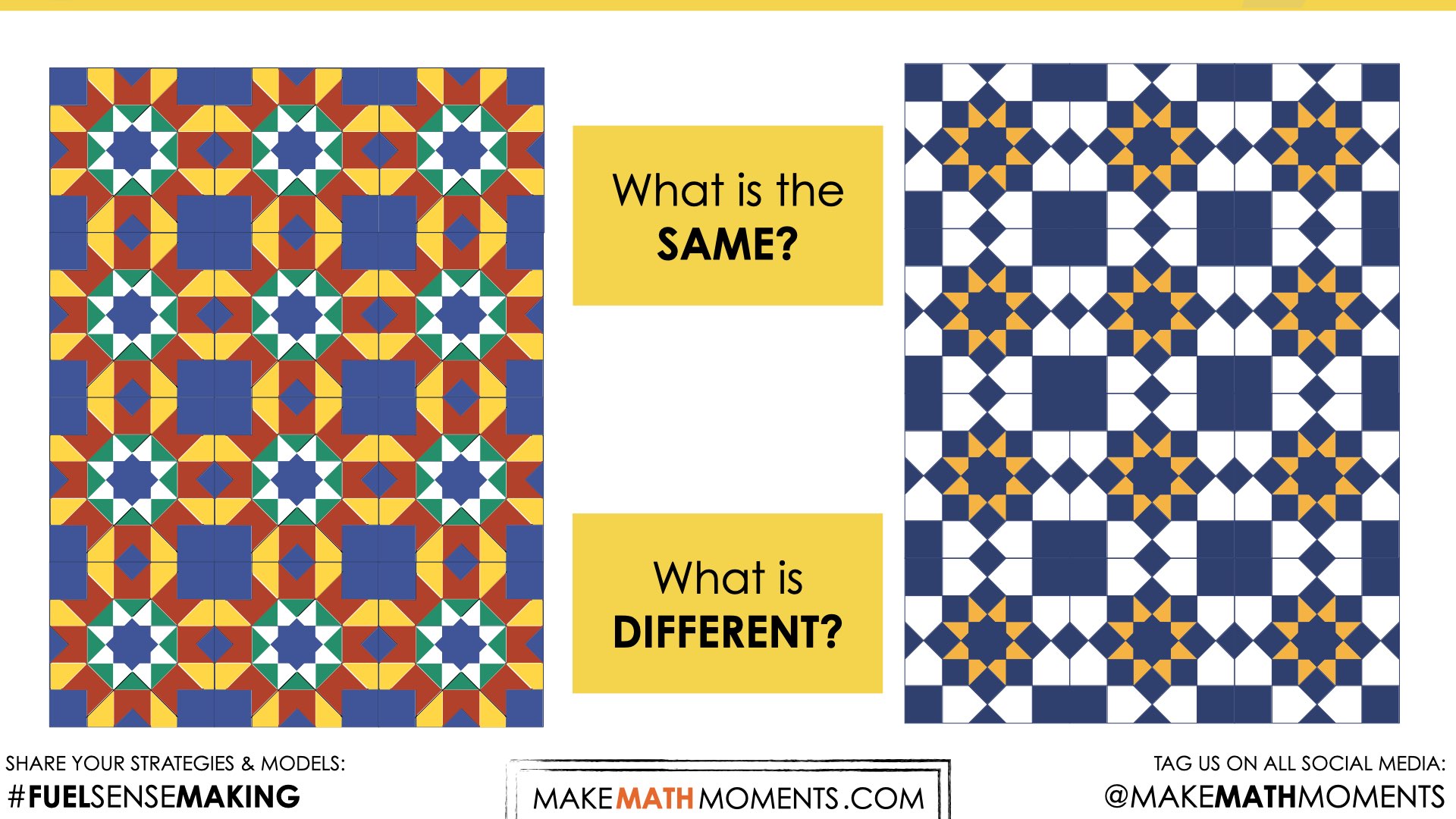
Then, ask students:
What do you notice?
What do you wonder?
Have students do a Think-Pair-Share routine:
- Students have individual think time to jot down ideas on paper or whiteboard.
- Students share their initial ideas with a partner.
- Students share as a whole group, either their own preference, or a meaningful observation they heard from their partner during the share (while giving credit to their partner). All contributions are acknowledged and recorded on an anchor chart on the board.
Spending time to acknowledge and address specific thoughts that students shared, whether a notice or a wonder, is crucial to building a culture in your classroom where students know that their voice is being valued and thus encourages them to continue sharing their thoughts and opinions later in this lesson and in future lessons.
Show students a close-up of the two tiles:
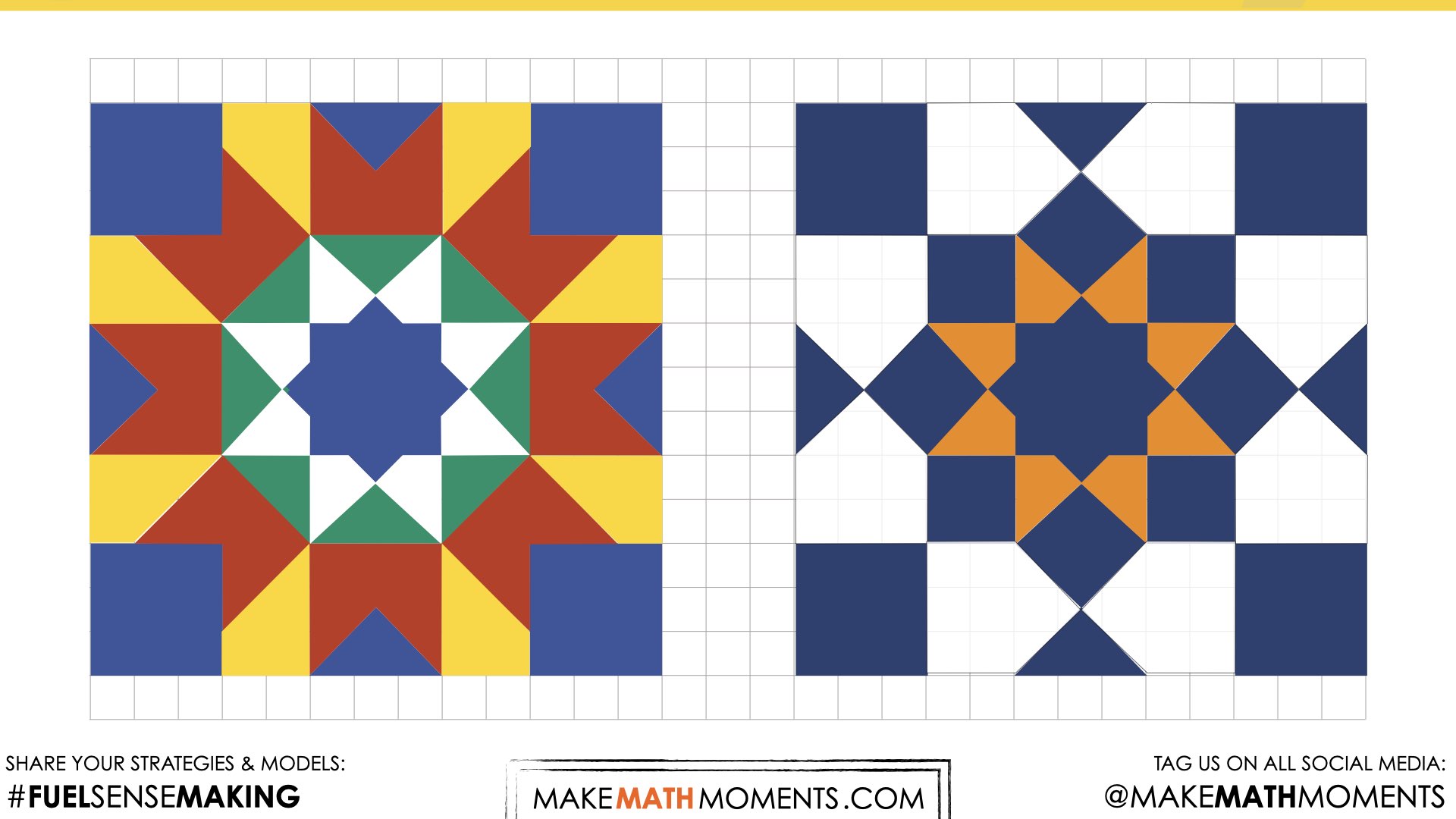
Again, have students do a Think-Pair-Share routine. They may build on previous observations or come up with new ones.
Notice and Wonder 2
The second part of the Notice and Wonder routine introduces the use of a coordinate plane to think about transformations.
Show students the following video:
Then, ask students:
What more do you notice? What else do you wonder?
Share your thoughts.
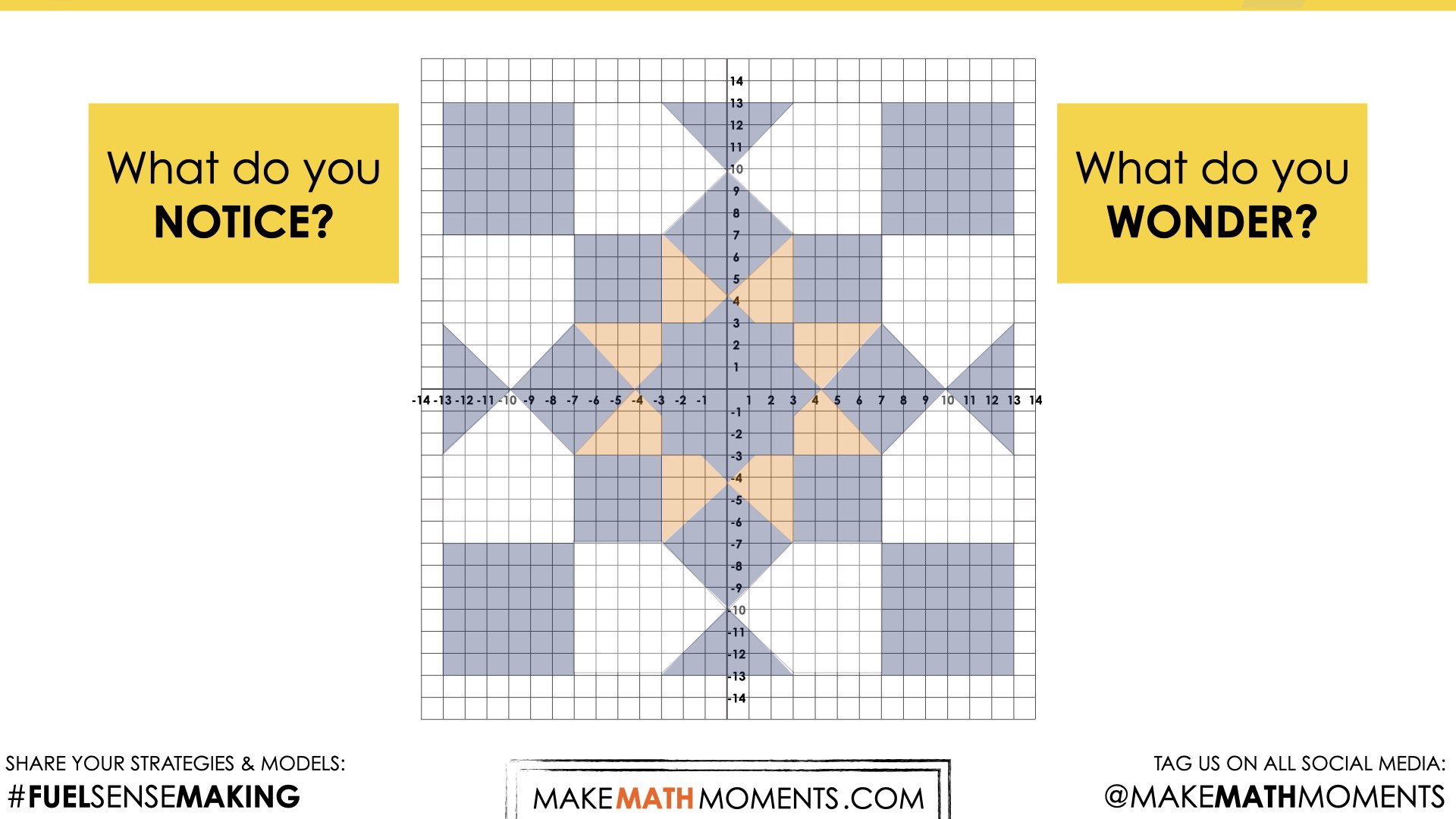
Possible observations and questions that may come up include:
- I notice they switched out the grid for a coordinate plane
- I notice that the grid has darker lines in the middle
- I notice that the squares are smaller
Once students’ initial ideas have been acknowledged and noted, the class can settle on a question to explore:
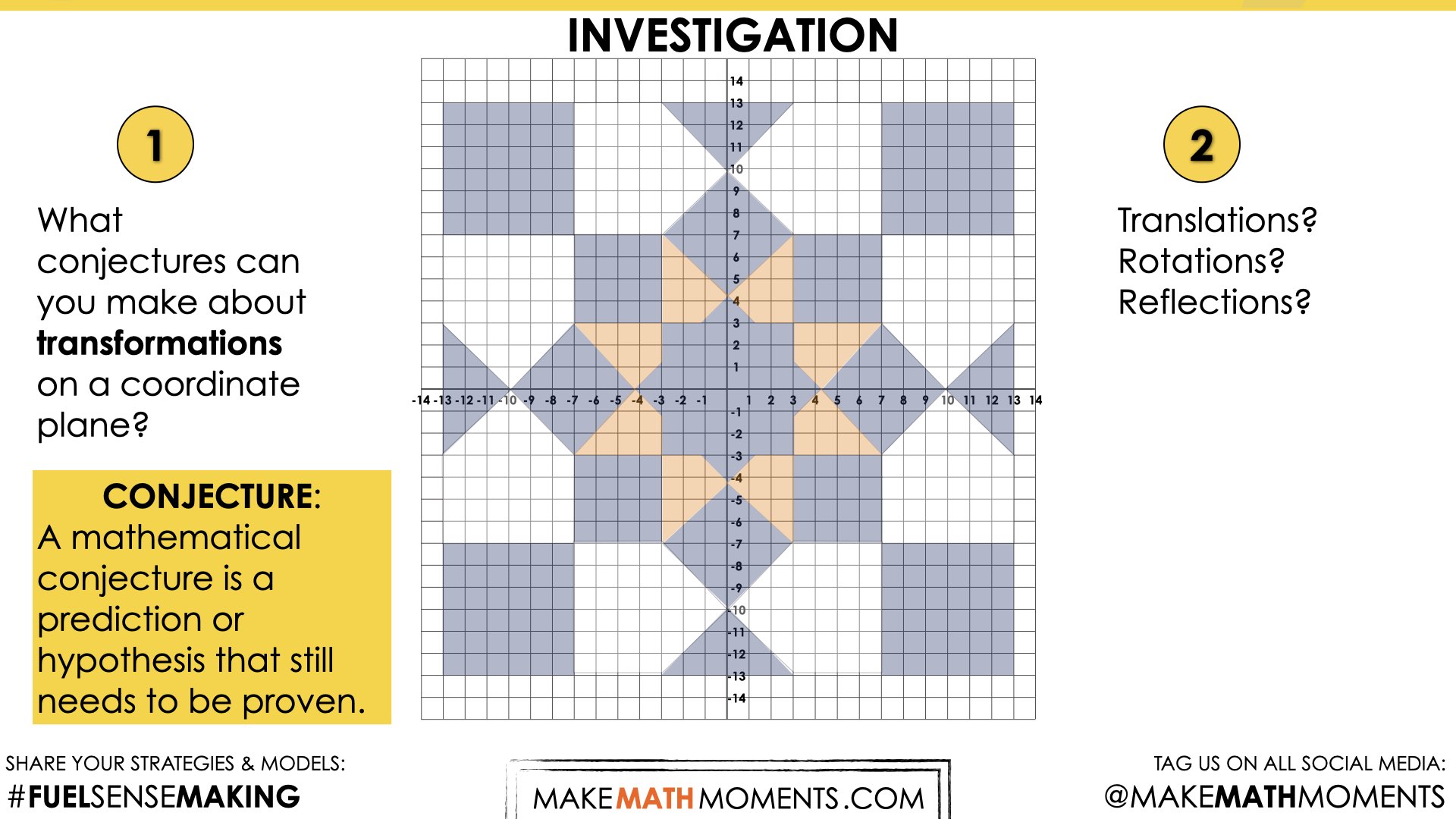
What conjectures can you make about transformations on a coordinate plane?
Elicit general ideas about translations, rotations and reflections and encourage students to ask questions. The questions will likely be general in nature, and a deeper understanding will emerge through exploration with the different types of transformations.
Without answering students’ questions, suggest students consider ways they might test their conjectures to support or refute them.
Fuel Sense-making
Investigation: Translations
Login/Join to access the entire Visual Prompt, downloadable slide decks and printable handouts for this lesson and all problem based units.
Investigation: Rotations
Login/Join to access the entire Visual Prompt, downloadable slide decks and printable handouts for this lesson and all problem based units.
Investigation: Reflections
Login/Join to access the entire Visual Prompt, downloadable slide decks and printable handouts for this lesson and all problem based units.
During Moves
Crafting a Viable Argument
Login/Join to access the entire Visual Prompt, downloadable slide decks and printable handouts for this lesson and all problem based units.
Math Forum
Login/Join to access the entire Visual Prompt, downloadable slide decks and printable handouts for this lesson and all problem based units.
Reflect and Consolidation Prompts
Consider making a visual note of the big ideas that emerge during the discussion in an anchor chart (a separate one for each type of transformation) for students to refer to.
It may also be useful to keep note of unresolved questions/unproven conjectures that students can keep in mind as they continue to deepen their understanding of rigid motion transformations.
Consider asking students to complete the following consolidation prompt independently.
Consolidation Prompt #1:
Login/Join to access the entire Visual Prompt, downloadable slide decks and printable handouts for this lesson and all problem based units.
Consolidation Prompt #2:
Login/Join to access the entire Visual Prompt, downloadable slide decks and printable handouts for this lesson and all problem based units.
Consolidation Prompt #3:
Login/Join to access the entire Visual Prompt, downloadable slide decks and printable handouts for this lesson and all problem based units.
We suggest collecting this reflection as an additional opportunity to engage in the formative assessment process to inform next steps for individual students as well as how the whole class will proceed.
Resources & Downloads
Login/Join to access the entire Visual Prompt, downloadable slide decks and printable handouts for this lesson and all problem based units.
Printable Lesson Plan PDF
Videos, Images & Media Files
Apple Keynote Presentation
Powerpoint Presentation
Printable Consolidation Prompts
Educator Discussion Area
Login/Join to access the entire Teacher Guide, downloadable slide decks and printable handouts for this lesson and all problem based units.
Explore Our 60+ Problem Based Units
This Make Math Moments Lesson was designed to spark curiosity for a multi-day unit of study with built in purposeful practice, number talks and extensions to elicit and emerge strategies and mathematical models.
Dig into our other units of study and view by concept continuum, grade or topic!


